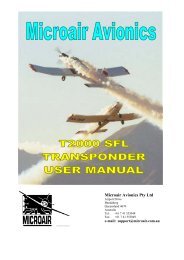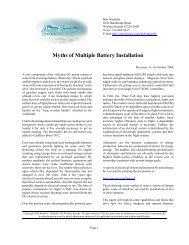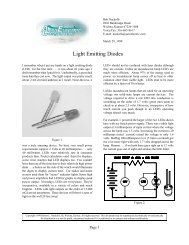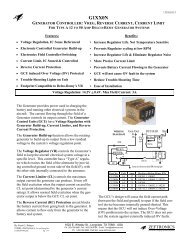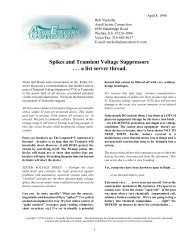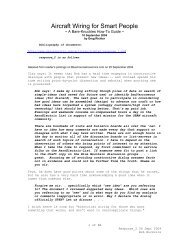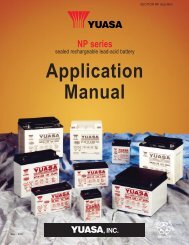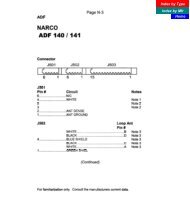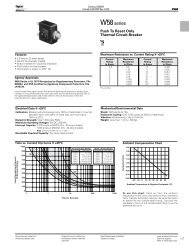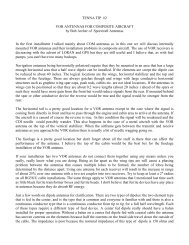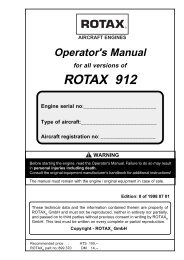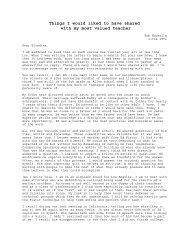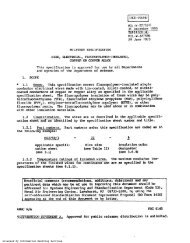Connector Tooling Guide - AeroElectric Connection
Connector Tooling Guide - AeroElectric Connection
Connector Tooling Guide - AeroElectric Connection
You also want an ePaper? Increase the reach of your titles
YUMPU automatically turns print PDFs into web optimized ePapers that Google loves.
IMPORTANT FACTSABOUT CRIMPING®DANIELSMANUFACTURINGCORPORATIONCRIMPING: THEN AND NOWThe first multi-pin connectors wereterminated by soldering the conductorto non-removable contacts. However,high temperature applications andthe need for simple and reliable fieldservice led to the introduction ofconnectors with removable contacts.These were crimped onto the conductorrather than being soldered.The first standard crimp tooldeveloped to crimp these new contactswas introduced in the earlysixties. MS3191-1, a military drawing,defined this tool and its accessories.The MS3191-1 utilized a four indentcrimp pattern together with a positivestop locator which controlled the travelof the indenters (crimp depth).The MS3191-1 design was acompromise between simplicity ofoperation and crimp performancesince the crimp depth for any givencontact was not adjustable to accommodatethe differing diameters of theconductors to which it would becrimped. It was, however, suitable forthe crimp connectors of that era.An improved tool design featuringindependently adjustable crimp depthswas soon introduced as MS3191-4.The MS3191-4 had an internal adjustment,totally independent of the locator,which permitted the selection ofseven separate crimp depths, allowingoptimal crimping of conductors rangingfrom AWG 12 to 26 regardless ofthe wire barrel size of the contact.MS3191-4 also introduced theuse of the double tipped indenter toproduce an eight indent crimp patternwhich has consistently achievedsuperior tensile pull off values.MS3191-4 introduced the conceptof a turret head containing three locatorswhich could be used withoutseparating any of them from the basiccrimp tool.In 1969 two military specificationsfor crimp tools were developed toreplace the existing military drawings.They were MIL-T-22520C (Navy) andMIL-T-83724 (USAF) which defined astandard size crimp tool similar to theMS3191-4, but with an expandedeight step crimp depth range. Thesespecifications also defined a miniaturecrimp tool to crimp conductors assmall as AWG 32.Both documents were combinedin 1971 into MIL-C-22520D. Allprevious military standards for crimptools were then cancelled includingthe MS3191.MIL-C-22520 has since replacedmany other crimp tool documentsincluding: MS3198, MS22910,MS17776, MS28731, MS90388,MS14037, MS27437, MS27828,MS27832, MS55619, MS27426 andothers. This list includes specificationsfor indent crimp tools, terminal lugcrimp tools, pneumatic tools, coaxialcable crimp tools and connectorsservice kits.The establishment of MIL-C22520was a milestone on the road to crimptool standardization. Its developmenthas eliminated the waste and confusionwhich accompanied the overlappingapplications of many different“standard” crimp tools called out by adeluge of unrelated military drawings.MIL-C-22520D for the first timeestablished a single specification whichset forth performance requirements forall crimp tools to be used on militarystandard electrical connectors.THE CRIMPING CONCEPTCrimping is a method of firmlyattaching a terminal or contact end toan electrical conductor by pressureforming or reshaping a metal barreltogether with the conductor. Theforming of a satisfactory crimpdepends on the correct combinationof conductor, crimp barrel and tool.When applied with a properlymatched tool a union would beestablished which has both goodelectrical and mechanical characteristics.The tool will provide theserequirements consistently and reliablywith repeatability assured by qualitycycle controlled tooling. There areseveral common configurations ofcrimped joint; several examples areshown below.The electrical resistance of aproperly designed and controlledcrimped joint should be equal to, orless than, the resistance of an equalsection of wire. Specifications statethe requirements in terms of millivoltdrop at a designated current.The mechanical strength of acrimped joint and hence its pull-outforce (tensile strength), varies with thedeformation applied. Therefore, byproperly shaping the deformation ahigh pull-out force can be achieved,i.e. the crimp die of the tool determinesthe crimp configuration anddeformation.The dies in the tool determine thecompleted crimp configuration whichis generally an element of contactand/or connector design. Some of thedesign considerations are: a) The typeof contact, its size, shape material andfunction, b) The type and size of wiresto be accommodated, c) The type oftooling into which the configurationmust be built.EIGHT INDENTFOUR INDENTTWO INDENTHEXAGONAL CRIMPCIRCULAR CRIMPB CRIMPNEST & INDENT CRIMPCAPTIVE CRIMPINSULATION DISPLACEMENT© COPYRIGHT 2003 DANIELS MANUFACTURING CORPORATIONPAGE 3



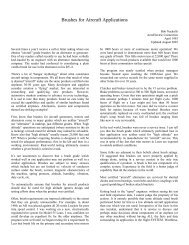
![G-Series-Ext [pdf] - Carling Technologies](https://img.yumpu.com/50918301/1/190x245/g-series-ext-pdf-carling-technologies.jpg?quality=85)
